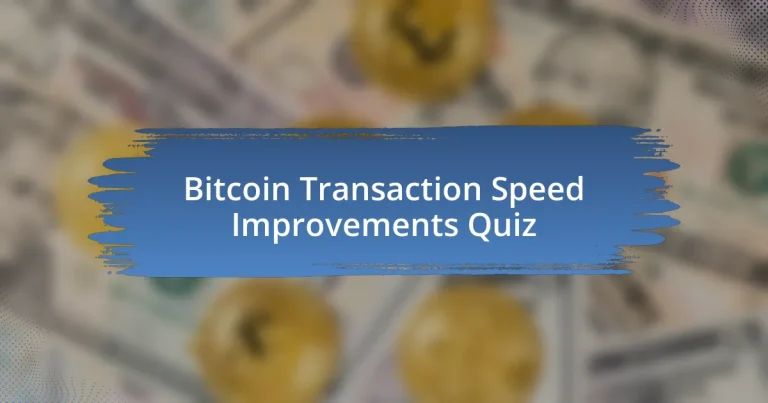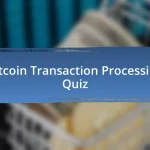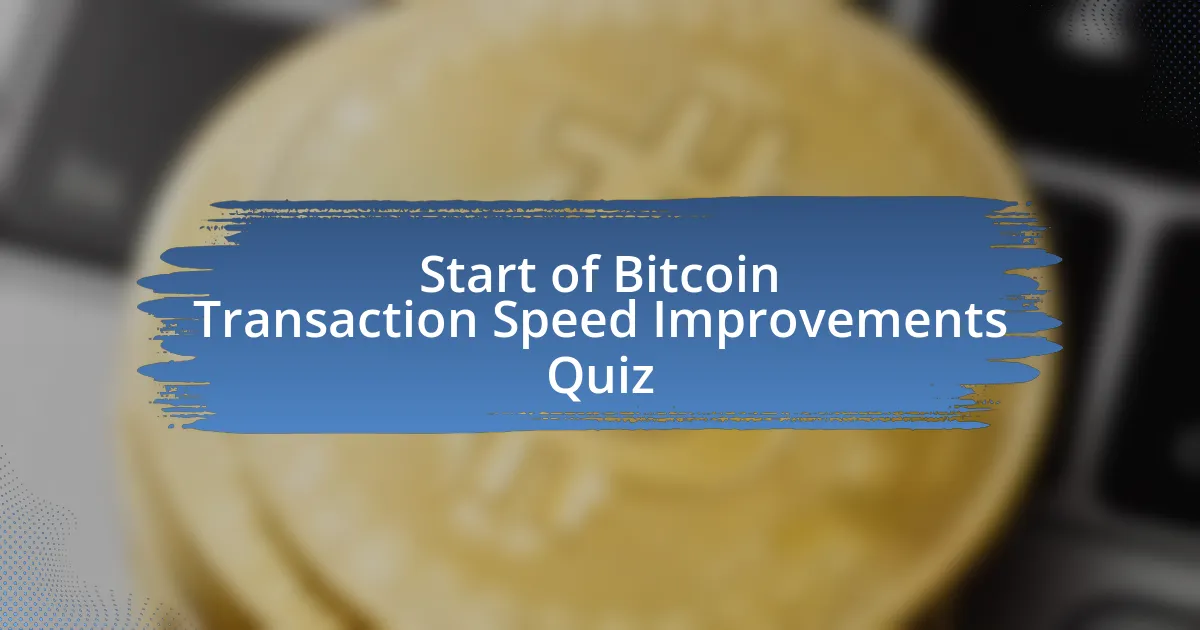
Start of Bitcoin Transaction Speed Improvements Quiz
1. What are the primary factors affecting Bitcoin transaction speed?
- Wallet compatibility, developer support, transaction history, and user authentication.
- Market volatility, price changes, user popularity, and transaction purpose.
- User interface design, transaction volume, mining difficulty, and confirmation time.
- Network congestion, scalability challenges, block size limitations, and network latency.
2. How does network congestion impact Bitcoin transaction speed?
- Network congestion improves transaction speed by prioritizing all transactions equally.
- Network congestion accelerates transaction confirmations by increasing block size.
- Network congestion has no effect on transaction speed or fees in the Bitcoin network.
- Network congestion leads to delays in transaction processing and higher transaction fees, especially during high demand periods.
3. What is the average number of transactions per second (TPS) on the Bitcoin network?
- About 70,000 transactions per second.
- About 700 transactions per second.
- About 7 transactions per second.
- About 70 transactions per second.
4. What is the Lightning Network, and how does it improve Bitcoin transaction speed?
- The Lightning Network is an off-chain scaling solution that enables faster and cheaper transactions by processing multiple transactions off-chain before settling them on the main Bitcoin blockchain.
- The Lightning Network is a mining technique that generates Bitcoin more quickly.
- The Lightning Network is a new type of cryptocurrency created to replace Bitcoin.
- The Lightning Network is an application that tracks Bitcoin prices in real-time.
5. What is the typical confirmation time for a Bitcoin transaction?
- About 30 seconds
- About 1 hour
- About 5 days
- About 10 minutes
6. How do transaction fees affect Bitcoin transaction speed?
- Higher transaction fees can speed up transaction processing, as miners prioritize transactions with higher fees.
- Lower transaction fees lead to faster processing by reducing miner workload.
- Transaction fees have no impact on how quickly transactions are processed.
- All transactions are processed at the same speed, regardless of fees paid.
7. What is the role of network latency in Bitcoin transaction speed?
- Network latency prevents any transactions from being processed.
- Network latency guarantees instant transaction confirmations.
- Network latency increases the block size limit for faster transactions.
- Network latency can introduce delays in transaction confirmation.
8. What is the Lightning Network`s approach to transaction processing?
- The Lightning Network only processes transactions on-chain, without any bulk settling.
- The Lightning Network eliminates all transaction fees completely by processing everything on-chain.
- The Lightning Network processes transactions off-chain and then settles them on the main Bitcoin blockchain in bulk, improving speed and reducing costs.
- The Lightning Network processes all transactions directly on the main blockchain without off-chain solutions.
9. How does the Lightning Network handle multiple transactions?
- The Lightning Network requires users to wait for each transaction to be confirmed on the Bitcoin blockchain individually.
- The Lightning Network creates payment channels between users, allowing them to conduct multiple transactions off-chain before settling the final balance on the main Bitcoin blockchain.
- The Lightning Network only handles single transactions and cannot manage multiple transactions at once.
- The Lightning Network processes all transactions directly on the Bitcoin blockchain without off-chain capabilities.
10. What is the scalability of the Lightning Network compared to the Bitcoin network?
- The Lightning Network can handle only a few thousand transactions per second.
- The Lightning Network can theoretically handle millions of transactions per second.
- The Lightning Network can handle about 1,000 transactions per second.
- The Lightning Network processes around 100 transactions per second.
11. What are the key features of the Lightning Network?
- Complex regulatory requirements and lengthy verification.
- Centralized data storage and fixed transaction limits.
- High transaction fees and slow processing times.
- Speed, low fees, scalability, and increased transaction privacy.
12. How do users set up and use the Lightning Network?
- Users must acquire and set up a Lightning-compatible wallet to use the Lightning Network.
- Users need to download a Bitcoin mining software to access the Lightning Network.
- Users are required to invest in hardware wallets to participate in the Lightning Network.
- Users must create an account on a centralized exchange to use the Lightning Network.
13. What is the typical transaction time on the Lightning Network?
- One hour
- Ten minutes
- One minute
- A few seconds
14. How do transaction fees compare between the Bitcoin network and the Lightning Network?
- Transaction fees on the Bitcoin network are lower than on the Lightning Network.
- Transaction fees on the Lightning Network are higher than on the Bitcoin network.
- Transaction fees on the Lightning Network are significantly lower than on the Bitcoin network.
- Transaction fees on both networks are the same across all transactions.
15. What is the purpose of Layer 2 solutions like the Lightning Network?
- To enhance blockchain efficiency by processing many transactions off-chain before settling them.
- To increase the block size limit for transaction verification on the blockchain.
- To create a centralized system for managing Bitcoin transactions.
- To eliminate the need for any transaction fees altogether.
16. How does network congestion affect the Bitcoin network?
- Network congestion simplifies transaction processing and reduces fees.
- Network congestion boosts the overall speed of Bitcoin transactions.
- Network congestion leads to delays in transaction processing and higher transaction fees.
- Network congestion has no effect on transaction speed or fees.
17. What is the role of block size limitations in Bitcoin transaction speed?
- Block size limitations allow for unlimited transactions per second.
- Block size limitations restrict the number of transactions that can be included in each block, slowing processing speeds.
- Block size limitations only increase transaction fees, not speed.
- Block size limitations have no effect on transaction speed in Bitcoin.
18. How does the Proof of Work (PoW) consensus mechanism impact Bitcoin transaction speed?
- The PoW consensus mechanism eliminates all transaction fees, making Bitcoin transactions instantaneous.
- The PoW consensus mechanism allows for unlimited transactions per second, speeding up Bitcoin`s processing time.
- The PoW consensus mechanism requires significant computational power to validate transactions, which slows down the processing time of transactions on the Bitcoin network.
- The PoW consensus mechanism requires no computational power, leading to faster transaction speeds.
19. What is the impact of high transaction fees on Bitcoin transaction speed?
- Higher transaction fees incentivize miners to prioritize transactions, potentially speeding up the processing time of transactions.
- High transaction fees slow down the processing of all transactions regardless of priority.
- High transaction fees make it impossible to process transactions during network congestion.
- Higher transaction fees have no effect on the speed of Bitcoin transactions.
20. How does the Lightning Network enhance user experience?
- It processes all transactions on-chain for better security.
- It increases block size limits and lowers fees.
- It creates more miners to enhance speed and efficiency.
- It removes waiting times and boosts transaction speed.
21. What are some strategies to minimize delays in crypto transfers?
- Strategies include never using fees, creating multiple wallets, and transferring during peak hours.
- Strategies include using Layer 2 solutions, opting for off-peak hours, and adjusting transaction fees.
- Strategies include relying solely on high mining power, waiting for confirmations, and using only the Bitcoin network.
- Strategies include buying more Bitcoin, investing in exchange stocks, and executing trades frequently.
22. How does Solana`s architecture improve its transaction speed?
- Solana relies on a proof-of-work consensus method that requires extensive computational power to validate transactions.
- Solana`s architecture uses a proof-of-history consensus mechanism that timestamps transactions, allowing for efficient processing.
- Solana`s design employs a maximal block size that limits the number of transactions per round, slowing down the network.
- Solana`s architecture integrates around-the-clock transaction verification by multiple independent networks.
23. What is the difference in transaction speed between Bitcoin and Ethereum?
- Ethereum processes transactions faster than Bitcoin, with an average time of 10 to 20 seconds compared to Bitcoin`s 10 minutes.
- Ethereum processes transactions slower than Bitcoin, with an average time of 30 minutes.
- Bitcoin processes transactions at the same speed as Ethereum, both averaging 10 minutes.
- Bitcoin has a faster transaction speed than Ethereum, averaging 5 seconds per transaction.
24. How does network congestion affect Ethereum transaction speed?
- Network congestion improves Ethereum transaction speed by allowing faster processing of transactions.
- Network congestion speeds up Ethereum transactions by reducing fees during high activity periods.
- Network congestion has no effect on Ethereum transaction speed and keeps it constant.
- Network congestion on Ethereum can lead to higher transaction fees and slower processing times, especially during periods of high activity.
25. What is the role of transaction fees in crypto transfer speed?
- Higher transaction fees can speed up transaction processing, as miners prioritize transactions with higher fees.
- Transaction fees do not influence speed; they are solely for security purposes.
- Transaction fees have no effect on transfer speed; all transactions are processed equally.
- Lower transaction fees lead to faster processing, reducing congestion on the network.
26. How does the Lightning Network handle micropayments?
- The Lightning Network charges high fees for every micropayment transaction.
- The Lightning Network requires a minimum transaction amount to operate.
- The Lightning Network is ideal for micropayments due to its low transaction fees, often fractions of a cent.
- The Lightning Network processes transactions over multiple blocks on-chain.
27. What is the security consideration for payment channels in the Lightning Network?
- Payment channels only function under high network congestion conditions.
- Payment channels are always secure, with no need for monitoring.
- Payment channels eliminate all forms of transaction fees.
- Payment channels must be monitored to prevent fraud, and there`s a small risk of funds loss if a node goes offline unexpectedly.
28. How does the Bitcoin network handle scalability issues?
- The Bitcoin network does not face any scalability challenges due to its design.
- The Bitcoin network processes all transactions on-chain without any enhancements.
- The Bitcoin network uses Layer 2 solutions like the Lightning Network to scale effectively.
- The Bitcoin network relies solely on increasing block size for scalability.
29. What is the impact of Layer 2 solutions on Ethereum`s transaction speed?
- Layer 2 solutions have no impact on Ethereum`s transaction speed.
- Layer 2 solutions significantly increase Ethereum`s transaction speed.
- Layer 2 solutions slow down Ethereum`s transaction speed.
- Layer 2 solutions decrease the efficiency of Ethereum`s network.
30. How can users avoid network congestion when making crypto transfers?
- Users can avoid network congestion by transacting only on special holidays.
- Users can avoid network congestion by making transactions during off-peak hours, such as weekends or early mornings.
- Users can avoid network congestion by making transactions at night only on weekdays.
- Users can avoid network congestion by increasing their transaction fees significantly.
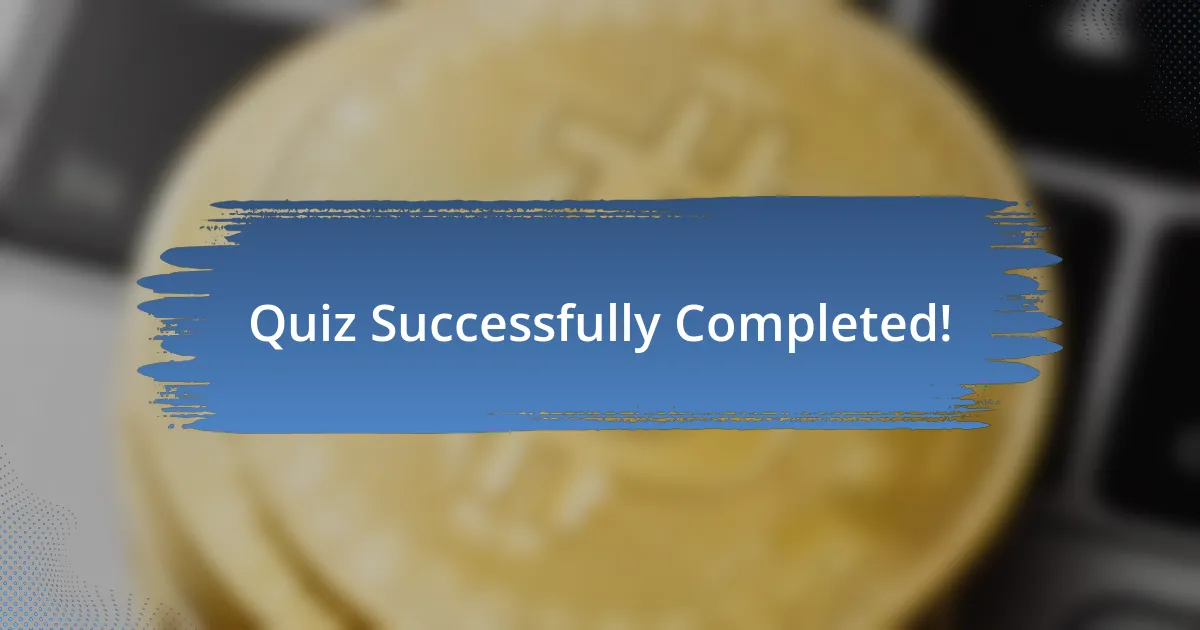
Quiz Successfully Completed!
Congratulations on completing the quiz on Bitcoin Transaction Speed Improvements! You’ve taken significant steps toward understanding how these advancements impact the larger cryptocurrency ecosystem. This process likely highlighted key concepts, such as transaction throughput and the role of solutions like the Lightning Network. Each question provided a glimpse into the intricate mechanisms behind Bitcoin’s evolution.
Throughout the quiz, you may have learned about the challenges Bitcoin faces concerning transaction speed and the various upgrades being proposed and implemented. Understanding these improvements not only enhances your knowledge of Bitcoin but also prepares you to engage in discussions surrounding its future. You’ve equipped yourself with foundational insights that can deepen your appreciation for this digital currency.
If you’re eager to expand your knowledge further, we invite you to check out the next section on this page. There, you’ll find comprehensive information about Bitcoin Transaction Speed Improvements, including detailed descriptions of innovative technologies and strategies in development. Your journey into the world of Bitcoin is just beginning, and we’re here to support every step of the way!
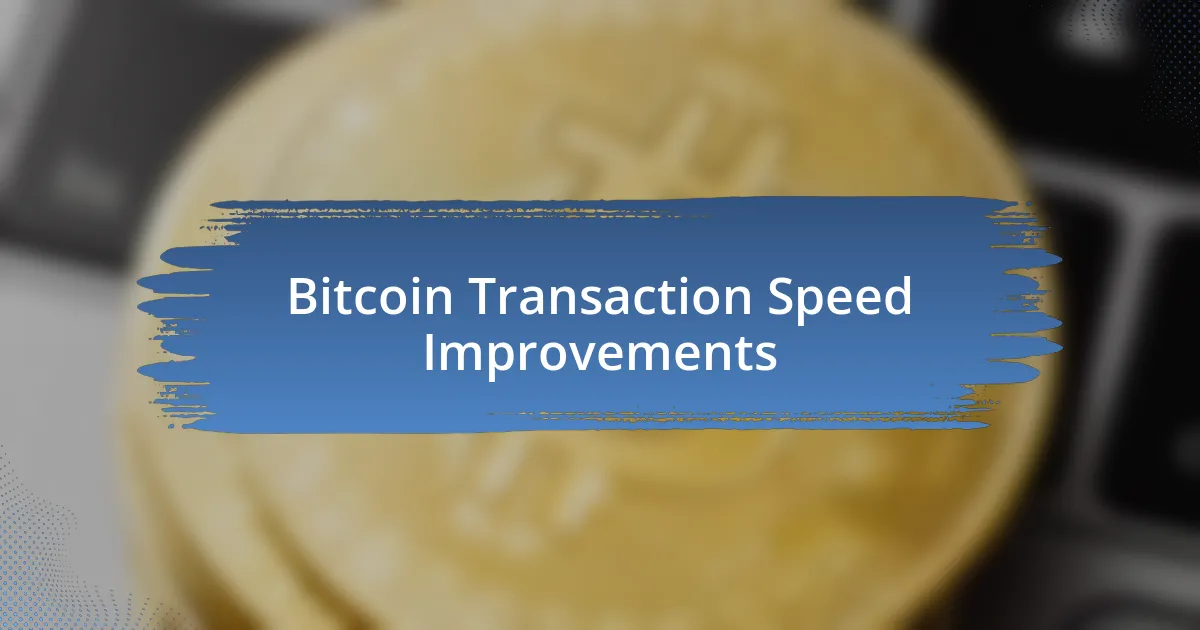
Bitcoin Transaction Speed Improvements
Understanding Bitcoin Transaction Speed
Bitcoin transaction speed refers to the amount of time it takes for a transaction to be confirmed on the Bitcoin blockchain. The typical confirmation time averages around 10 minutes, largely due to the network’s design of adding a block approximately every 10 minutes. Factors influencing this speed include network congestion, transaction fees, and block size.
Factors Impacting Bitcoin Transaction Speed
Several key factors affect Bitcoin transaction speed. Network congestion occurs when there are more transactions than can be processed within a given time frame. Transaction fees play a crucial role; higher fees often lead to faster confirmations as miners prioritize profitable transactions. Block size limitations also restrict the number of transactions included in each block.
Scalability Solutions for Bitcoin
Scalability solutions aim to improve Bitcoin’s transaction speed by increasing the number of transactions processed. Technologies like the Lightning Network enable off-chain transactions, which significantly reduce the burden on the main blockchain. This allows for faster transactions without overloading the network.
Recent Developments in Bitcoin Protocol
Recent updates to the Bitcoin protocol have targeted transaction speed enhancement. BIP 340 introduced Schnorr signatures, which optimize transaction sizes and improve signature aggregation. This effectively allows for more transactions to fit in a block, thus enhancing overall speed.
Impact of Transaction Fees on Speed Improvements
Transaction fees are a direct incentive for miners, influencing how quickly transactions are processed. When networks experience high demand, paying a higher fee can expedite transaction confirmation. As a result, more users are incentivized to adjust their fees dynamically based on current network conditions, leading to faster transaction speeds for those who opt to pay more.
What are some methods for improving Bitcoin transaction speed?
Bitcoin transaction speed can be improved through various methods such as increasing block size, implementing the Lightning Network, and employing Segregated Witness (SegWit). Increasing block size allows more transactions per block, thus speeding up processing. The Lightning Network enables off-chain transactions, significantly reducing the time for confirmations. SegWit separates signature data from transaction data, which increases block capacity and efficiency. Each method has been validated through extensive usage and community support since their implementations.
How does the Lightning Network enhance Bitcoin transaction speed?
The Lightning Network enhances Bitcoin transaction speed by facilitating off-chain transactions that do not require immediate inclusion in the blockchain. It creates a network of payment channels between users, allowing them to transact instantly without congestion issues associated with the main Bitcoin network. According to the Lightning Network Statistics, the average transaction time is reduced to seconds, proving its effectiveness in speeding up transactions.
Where can users find information about Bitcoin transaction speeds?
Users can find information about Bitcoin transaction speeds on blockchain explorers like Blockchair or blockchain.com. These platforms provide real-time data on transaction processing times and network congestion levels. Additionally, websites such as BitcoinAverage and CoinMarketCap also display average transaction fees and confirmation times, offering a comprehensive view of the current state of Bitcoin transactions.
When was Segregated Witness (SegWit) implemented to improve transaction speed?
Segregated Witness (SegWit) was implemented on August 24, 2017. This upgrade aimed to address transaction malleability and enhance block size efficiency. Post-implementation, several studies confirmed that SegWit increased the effective capacity of the Bitcoin blockchain by approximately 1.7 to 2.0 times, leading to faster transaction confirmation times and lower fees.
Who is responsible for the development of Bitcoin scalability improvements?
The development of Bitcoin scalability improvements involves several key individuals and groups, primarily the Bitcoin Core development team. Notable contributors include developers like Gregory Maxwell, Pieter Wuille, and Wladimir van der Laan, who have played significant roles in advancing technologies such as SegWit and the Lightning Network. Their contributions are documented in Bitcoin Improvement Proposals (BIPs) and through ongoing software updates, showcasing their commitment to improving transaction speeds.
